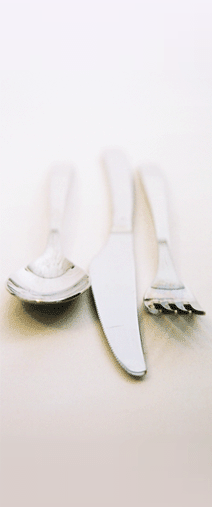Aiy ! Aiy! Aiy! Qué Calor!
July 29, 2006
12:05 PM
Reporting from Manilva on the very southern tip of Spain.
We have driven down here in our (un-air conditioned) car.
A drive and a half.
Sile feels she should be awarded the V.C for enduring it.
It started in Cherbourg 11th July and we now have over 2000 miles on the clock.
We are staying with friend (and best man) Michael.
It hasn’t been all driving though.
Highlights have been.
Wonderful campsites in Mayet in the Loire,on top of the Sierra Espuna in Murcia, and in Dilar near Granada.
Great week spent in luxury in a villa in Goudargues in the Ceze valley with the usual suspects (and a great days canoing down the Ceze)
A visit to The Alhambra Palace in Granada.
Words fail me, the photographs will have to do.
There is more to come.
I will blog and put up extensive photographs once I get home.
I am filling up a large foolscap book with a long hand journal and have taken several hundred photographs.
All will be transcribed on return.
We still have a trip to the Languedoc to look forward to,to look at houses.
A visit to friends Isabel and Paul in Annecy.
And we may even manage to stay with brother and sister in law in Normandy
should they be “at home” as we pass by.
Watch this space.
Oh and the title.
This is the greeting all elderly Spanish ladies give each other during this time of heat.
The greeting is properly given with much fluttering of a hand held fan.
Lost in Translation Eleven
July 9, 2006
05:28 AM
It was in 1997 when we decided to drive down to see our friends in Munich.
The daughters ranged in age from 12 to 6 at that stage and our friends Miriam and Heinz, who lived right in the centre of Munich, also had two daughters, Anna and Sophie who were about 4 and 1.
We were never afraid of long car journeys so we packed us all into our grey Cortina and drove through England and France all the way there.
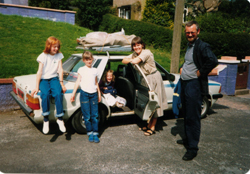
The Cortina turned out to be a bit of a goer, we were amazed at the speeds it picked up on the German Autobahns, probably just anxious not to let itself down in front of the Audis and BMWs.
We had, fortunately, taken out the AA Five Star insurance because we needed it as soon as we arrived at our friends house in the Kreuzstrasse, right in the pedestrianised centre of Munich.
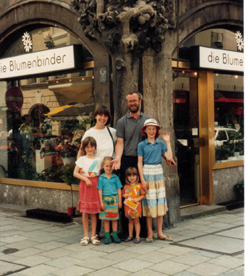
The Dwyers with Anna on the Kreuzstrasse
It was while parked there that the Cortina decided to have a problem starting.
This was when the insurance proved invaluable ,because the German equivalent of AA fixed us up instantly, and free of charge, there and then.
The week in Munich was brilliant, we packed a trip to Garmish, climbed the Zugspitze (by cable car) and even found some time to enjoy the excellent beer in the beer gardens.
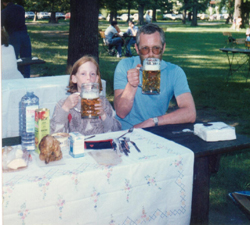
Drinking our Maas in Munich
Caitriona showing an early fondness for the large glass
On the trip back through France we had a truly European moment, and one that fits nicely, if accidently, under the title of this piece.
While we were having lunch in a café in Alsace, about 50 klms inside the French border, a German party with absolutely no French came in.
As the proprietor had no German, and he had seen that we (who he assumed to be German ) had French he asked me to translate the menu for them.
So happened a wonderful moment as an Irishman,far from home, translated for two European people about a half hours drive from their border!
We were stopped in a camp site close to our ferry in Dieppe when the Cortina did its thing again and refused to start. The local garage soon had us going on our way and this time they also explained where the problem lay.
The Cortina had an automatic choke which was getting jammed, this was flooding the engine and causing the difficulties with starting.
The French term for an automatic choke was a little Franglais; it was a Starter Automatique.
Now I had never heard of an automatic choke before so this term became firmly imbedded in the brain.
It is a funny thing about language but the original imprinting seems to stay with one for life.
As I first came across the Guinea Fowl while we were in France in the seventies they will always be Pintade first to me while I then search the mind for the English word.
But to get back to the title of this piece.
It wasn’t long of course, before the cars little problem came back to us at home in Ireland.
This time I was totally knowledgeable and informed our Waterford mechanic, to his utter bewilderment, that I knew exactly where the problem lay.
“It gets stuck,” I explained, “It’s the automatic Starter”
Afterword:
A propos of nothing in particular I want to congratulate myself on this, my 250th blog.
How time flies.
1 comment.
Deirdre
July 8, 2006
12:06 PM
Check out the youngest daughter Deirdre(No.2) as one of the “rising stars of Irish Theatre” in todays Irish Times.
Oh the vanity of fatherhood!
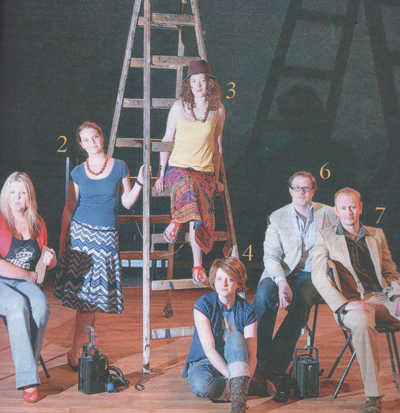
1 comment.
The Surrender of Granada
July 7, 2006
11:50 AM
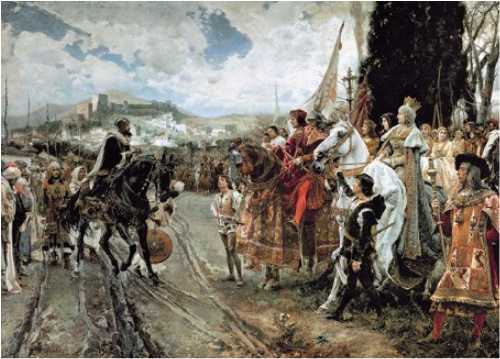
by Francisco Pradilla Ortiz
1 comment.
Le Petit Dejeuner sur l’Herbe
July 7, 2006
11:32 AM
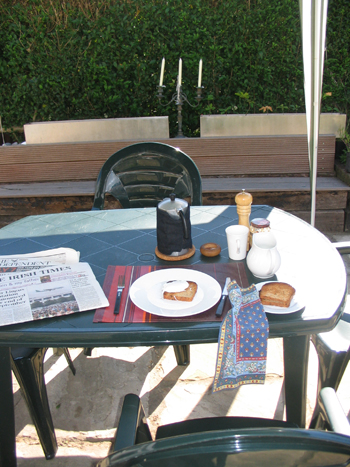
Or just because we are outdoors there is no reason to let our standards slip!
Grand Nephew Rory
July 6, 2006
13:38 PM
Petra in Pink
July 6, 2006
09:26 AM
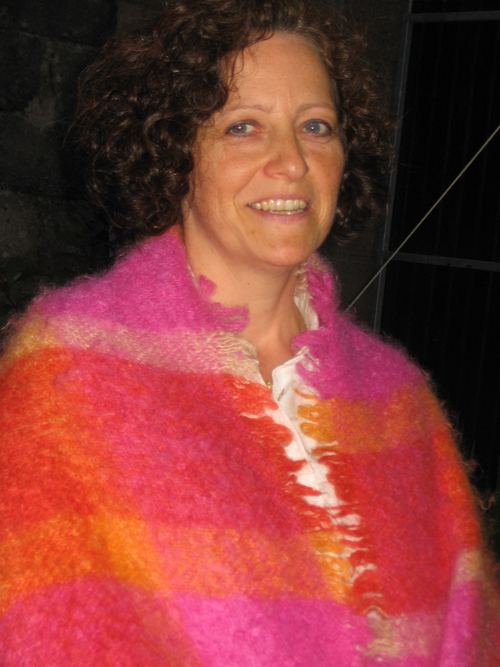
(taken by Síle)
1 comment.
Eve’s Chocolate Cake
July 4, 2006
17:20 PM
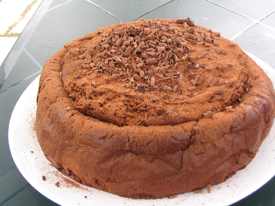
This recipe came from the Australian chef Damien Pignolet, who in turn got it from his friend Eve, thus the title.
This is a must for anyone who feels that cakes are spoiled by the cooking and would rather lick the raw batter in the bowl than eat the finished cake.
It is really just a chocolate mousse, but made with very dark chocolate, ¾ s of it is cooked and ¼ remains uncooked as a gooey middle.
Note the superb simplicity of the ingredients, just chocolate and eggs, with a tiny amount of butter and even less sugar.
You would be hard put to find a better example of Escoffier’s dictum:Faites Simple.
One essential of this recipe is to use best quality chocolate, I used a 75% Cocoa one which worked well.
The truly courageous could try one with an even higher count!
Eve’s Chocolate Cake
360g dark chocolate, chopped into small bits
50g unsalted butter
12 large eggs, separated
50g caster sugar
a little extra dark chocolate and cocoa to decorate
Grease a 26-28cm springform cake tin and line the base and sides with baking paper.
Preheat the oven to 150C, 300F.Gas 2.
Melt the chocolate in a bowl over a bain-marie of hot (but not boiling)water-or in a microwave- and then work in the softened butter.
Beat the egg yolks with 30g of the sugar until pale.
Then combine them with the chocolate and butter mix.
Beat the egg whites until stiff but not dry.
Then beat in 20g of the sugar until stiff.
Beat ¼ of the egg white mixture into the chocolate mix.
Fold this gently but thoroughly back into the remaining egg white mixture. Transfer ¼ of the cake mixture into a bowl and refrigerate.
Pour the balance of the mixture into the prepared tin and bake for 30-40 minutes.
It should remain slightly moist in the centre.
To test, press the centre with your finger after 30 minutes – it should hold the indentation.
When the cake is ready, invert it onto a serving platter.
Remove the ring and base.
Leave it to cool completely.
The cake should collapse and leave a crater in the centre.
Fill the crater with the reserved cake mix and dust lightly with cocoa.
Scatter over the extra bits of grated chocolate.
Serve with whipped cream.
Post Script on July 6th.
Sile thinks it is a little too bitter so another 20g of sugar with the egg yolks might be a good idea, especially if using such a dark chocolate.
1 comment.
Leaf Circles
July 4, 2006
13:24 PM
A couple of months ago our friend Siobhan Denman gave us a present of two roses for our new garden.
One of the plants thrived and has produced an abundant crop of dense and sweet smelling roses,
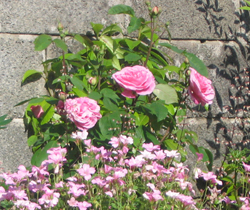
the other one, which we planted close to it has been fairly stunted.
We noticed fairly early on that there seemed to be several holes in the leaves. These were very regular, semicircular holes which looked like they had been cut by an expert with a jig saw and a compass.
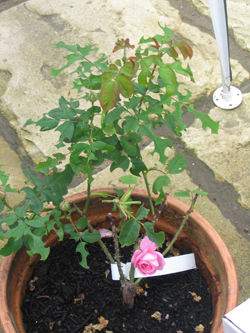
We assumed that this was some sort of vine weevil and so we moved the plant out of its site and into a pot to see if we could lose its parasite.
All went well for a few weeks and the rose was well on the way to recovery when the maniac hole cutter struck again.
At this stage we decided to abandon it to its (stunted) fate, and were just grateful that it was leaving the rest of the plants alone.
Then on Friday Sile brought home those plants which she had been growing for her pupils in school.
One of these was the shoots of the seeds of a strange Laburnum type plant which she had pocketed in the garden of Gualtiero Marchesi’s Restaurant in Ebrusco in Italy last September.
We left the pots with these seeds in the garden while we found lunch and when we came out again about 30 mts later we found that the leaf cutter had struck again.
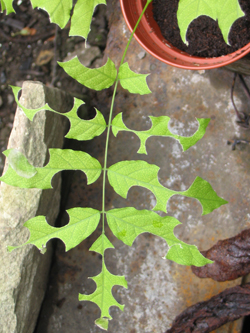
This time we had obviously provided something utterly irresistible!
Sile headed off to the internet to see what the dickens we had, this was obviously not a weevil, unless it was a super charged one!
She found the following;
Leaf-cutting bees (Megachile species)
Plants affected
Many plants, but roses are a particular favourite.
Symptoms
Neat, elliptical segments are cut out of the leaf margins, particularly of roses. The adult bees are more hairy and broader than a honeybee. Leaf-cutting bee females are 10-15mm long and the underside of the abdomen is covered in ginger hairs. The nests are made in tunnels in rotten wood, hollow plant stems or in flower pots and seed trays, especially where the compost has dried out.
Cause
This is the work of leaf-cutting bees that use the leaf segments in the construction of their nests. Rose leaves are particularly favoured, but other plants are also used. The female bee carries one leaf piece at a time back to her nest.
Each thimble-shaped leaf cell is then stocked with a mixture of nectar and pollen on which the bee lays an egg, before capping the cell with circular pieces of leaf. The process is repeated until the nest may contain up to 20 cells. The nests are sometimes found when glasshouse plants are being repotted or old seed trays emptied; by then the leaves may have become greyish brown and the cells may contain white grubs which will pupate and emerge as adult bees the following year.
These bees are solitary with each female having her own individual nest that she constructs and provisions on her own. The females have stings but lack aggression and do not chase or sting people. Most plants tolerate the damage, although small plants may suffer a significant loss of leaf area. Nests in flower pots have little impact on the plant unless it is growing in a small pot.
So this was no weevil, but a bee doing some nest lining.
We watched the plant carefully and, sure enough we found the bee at his work and were able to follow it to its leaf lined nest in the wall
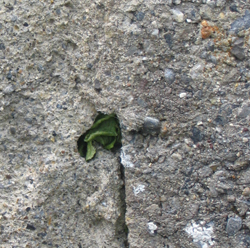
A learning experience this gardening!
Une Affaire de Coeur
July 3, 2006
11:15 AM
I think a lot of our friends and relations think that we are completely stuck in our ways as we proceed to take nearly all of our holidays in the same country; France.
Everybody, it seems, has moved on.
The modern destinations now are places like Slovenia or Croatia and, in the Irish winter, there is a definite exodus to the islands in the Atlantic.
Meanwhile we remain loyal to France.
I think I have already pointed out the French plusses, the food, the culture, the language, their remarkable maintenance of their culture and their climate. All of these plusses could be observed in several other countries and, lets face it the climate is not all that fantastic in France outside the summer months.
The only logical answer then must be that our attachment must be an affair of the heart, and, like other romantic attachments this one does a fairly good job of shielding us from our loved one’s faults.
If I was to point out the moment when this love affair started I think I would have to say that it was on a family holiday we took on the French Riviera in November in 1990.
Looking back it must have been a moment of great and foolhardy courage for us to head off at the end of October, with our three daughters (aged 13, 10 and 7) with a fly drive ticket to Nice, with very little money, and nothing booked bar the first evening in a chambre d’hote near the airport.
From there we headed off up the Alps, driving on hair-raising corniches (I remember having to stop the car and dry my sweating palms which were in danger of slipping on the steering wheel)
We eventually found ourselves at night fall in the tiny village of Peille and managed to get a some rooms in a small hotel.
(They were a little surprised that we didn’t want dinner, the truth was that we had stopped at a supermarket and, like proper cheapskates, bought a picnic dinner to eat in our rooms)
The first moment of magic happened in the morning when we opened the shutters.
It was a glorious day and we were perched high up in the mountains with a beautiful view all the way down to the sea at Monaco.
It was quite magical.
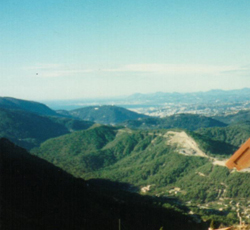
This is this moment taken on my ancient Instamatic.
The following day we managed to persuade the owner of a campsite in St. Paul en Foret to let us have one of his chalets (we were the only people there) so we at least had the accommodation sorted for the rest of the week.
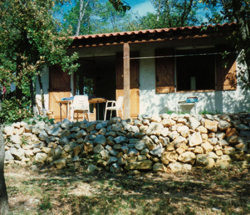
The chalet in St. Paul
The second moment of magic happened when we headed off to walk the fields by the campsite on our first morning there.
Intrigued by the heady smells which were rising as we walked we discovered that we were walking on lawns of wild thyme, I crushed a black berry growing on a conifer and suddenly was surrounded by the smell of gin, it was, of course, Juniper, then to all of our amazement we found ourselves in an orchard of Olives, the first time any of us had seen these fruits outside jars.
That afternoon we went to Monaco to the aquarium, which the children loved, the moment I remember best was looking out a window and seeing dolphins leaping in the Mediterranean.
As we walked through the town we had another first as one of the children grabbed me and said “ What’s that on the tree?”
So we saw our first growing lemon.
It was while staying in St. Paul that I went to an brocante fair in Feyance and bought my very first absinthe glasses.
This was also the holiday which we visited the Peyraud family in Bandol and were given a full tour of their Domaine Tempier and their amazing wines.
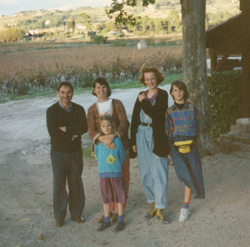
The Dwyer ladies with Jean-Marie Peyraud in Domaine Tempier
(We had no idea what a privilege this was, it was many years later that I realised the eminent food writer Richard Olney has written a cook book, A Provencal Table, which is exclusively recipes from this family and that the house in which they received us features in just about every book on Style Provencal, the family afterwards also paid us the compliment of coming to eat in our restaurant in Waterford.)
So it was a great holiday, a fitting start of a love affair.
I must also point out that we were extremely lucky with the weather which was glorious for the week, so much so that we went swimming in Antibes.
This was when the Riviera showed us its less savoury underbelly.
While we were swimming some thieves broke into our hired car, but again on the plus side all they managed to steal was one of the children’s tape machines and, as the car was a hired one we has a replacement organised in Cannes within hours.
Funnily we have never gone back to the Riviera since.
I think we hit it at it’s perfect month, quiet November.
A good month for starting love affairs.
|
